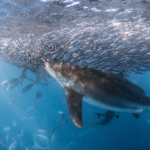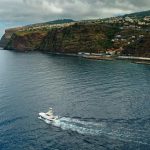Unusual Year So Far, But Likely to Improve
Background:
Since 2003 we have been developing an objective method for forecasting the overall fishing action at all of the Bahamas Billfish Championship (BBC) tournaments. The hypothesis for forecasting the seasonal marlin fishing action stems from the location and geographic extent of the bluer and often warmer water that occurs from the Cat Island ? San Salvador Island area where it is presumed that the marlin concentrate before and during spawning. We have been calling this water “blue marlin water.” We assume that the marlin are associated with this water and the more “blue marlin water” that exists in the Abaco Islands and Eleuthera Island areas, the greater the marlin relative apparent abundance will be in these areas.
Based on our observations of the fishing action in the Bahamas over the last 20 years it appears that excellent fishing action overall occurs within the BBC tournament area when there is a substantial volume of the “blue marlin water” pushing over the 100 fathom ledges along the eastern side of Eleuthera and Abaco. Relatively good fishing seasons occur when this water occurs over the 1000 fathom curves, but not the 100 fathom curve of both areas. Mediocre years occur when there is a lack of this water over these areas. Good fishing action is also linked to favorable currents and when the water mass boundaries of these currents are stable for three to five consecutive days over good bottom topography to concentrate the bait. For the BBC tournament areas, the dissolved oxygen concentration does not appear to be a major factor compared with the temperature and clarity of the water. In other areas south, the dissolved oxygen is a major controlling factor on fish distribution.
During the last several years, the conditions were particularly favorable as early as January and February in terms of the presence of “blue marlin” water off Abaco and Eleuthera. However, due to the currents generated by relatively large eddy features located 60-90 miles northeast of Eleuthera, the ?blue marlin? water was pulled away from the BBC tournament area. In these years there have been several days when some of this water moved into the tournament area and catch rates increased. Unfortunately, these favorable conditions were not persistent throughout the entire tournament season.
One of the challenges of producing a forecast of the oceanographic conditions for the BBC Tournament is that these fishing events extend over a relatively long time frame, from the last week in April through the third week of June, 2011, and that conditions are likely to change dramatically from one event to the next. In addition, there are no reliable numerical oceanographic models or even atmospheric models to use to make high resolution forecasts. The models provide some guidance, but for the needed spatial and temporal resolution, we are forced to rely on our qualitative experience as we have been monitoring the conditions over the Bahamas for over 20 years. This experience is based on the satellite observations of the ocean conditions derived by Roffer?s Ocean Fishing Forecasting Service, Inc. ? ROFFS™ (roffs.com) on a near hourly basis. The satellite data (infrared for sea surface temperature and ocean color for indices of phytoplankton, clarity, and colorized dissolved organic material) are received from a variety of sources including, but not limited to NASA, NOAA, and the European Space Agency. We also use data derived from drifting buoys and from satellite altimeters. The altimeters provide a very course resolution and the time delay (10 day mean) limits the data?s utility. In addition, we also rely on climate data, analyses, and forecasts provided by Columbia University?s International Research Institute for Climate and Society, known as IRI (http://portal.iri.columbia.edu/portal/server.pt), and NOAA?s climate prediction website (www.cpc.noaa.gov/), as well as, the Florida State University Center for Ocean-Atmospheric Prediction Studies program (www.coaps.fsu.edu).
Each year we are asked about the El Ni?o ? La Ni?a situation although there are no obvious direct effects on the ocean conditions during the BBC tournament season. Perhaps by next year we will learn to use another index like the North Atlantic Oscillation (NAO) index. In the meantime we will discuss the popular conditions. Presently there is a La Ni?a condition in the eastern tropical Pacific Ocean that is weakening. By June the El Nino Southern Oscillation (ENSO) index conditions are forecasted to be neutral by the NOAA Climate Prediction Center. However, this suggests an enhanced chance for below-average precipitation and above average air temperatures across a substantial portion of the U.S. southern states west of Florida. However, Florida and the northern Bahamas are forecast to have ?normal? or mean air temperature conditions. The southern Bahamas and Caribbean Sea area is forecast for below normal conditions. The forecast for south Florida is for slightly below normal precipitation, normal for the Bahamas and slightly below normal for the Dominican Republic. As we enter ENSO neutral conditions, we anticipate that the air temperature and precipitation will not be controlled by the ENSO circulation, but more zonal with tropical conditions dominating the control of the weather.
We have learned that it is important to consider the present conditions (end of February ? beginning of March) in the area covering south Florida to the Bahamas as an indicator for determining if we are experiencing warm, cool, or mean conditions. [We have learned this because big and bad Al Behrendt (ruler of the BBC Tournament) makes me ?an offer I can?t refuse?, without payment into making a long term fishing forecast.] The nine year (2003-2011) mean sea surface water temperature (SST) for the core of the Gulf Stream off Miami is 78.2?F during our standard March 05- 06 measurement period. The range has been as low as 74.8?F (2009) to a high of 80.5?F (2007). This year the SST was 78.1?F. While have not been recording the SST off Cat Island during this same period, the four year mean (2008 ? 2011) SST for the Cat Island area is 75.6?F and this year the SST was 74.3?F. However, the blue marlin water is not presently surrounding Cat Island, rather it is around the San Salvador area and farther south which is not a good omen for blue marlin fishing action during the BBC.
Figure #1 and Figure #2 represent the ocean conditions at the end of February, 2011. Figure #1 is a false color enhanced thermal infrared image for sea surface temperature composed of satellite data observed on February 20th and 22nd. Figure #2 is a false color enhanced ocean color image for the same period ( February 20th and 22nd ).
The warmest and bluest water in Figures #1 and #2 is the ?blue marlin water? and extends from the area southeast of Cat Island to the area northeast of Cat Island, east of Eleuthera and east of Abaco. The motion of the water is complex and since a movie often provides more details than the space here allows for a text description, we have made a movie loop for your viewing. See the QuickTime movie below that allows you to visualize the motion. This movie is composed of daily satellite images looped into a movie. Overall the ?blue marlin? water is being pulled offshore of Long Island (south of Cat Island) by a relatively large clockwise eddy that is centered approximately 45 miles east of San Salvador. This eddy is pulling the water northeastward and a significant amount of this water is being pulled farther offshore from Cat Island and Eleuthera by a counter-clockwise eddy that is centered approximately 60 miles east of Eleuthera. This is not favorable for good blue marlin action over the ledges off Cat Island and Eleuthera. See Figure 3 (below) for a better view of these eddy features during March 10-11, 2011 despite the cloud interference in the northern part of the satellite image. Due to other eddy features located farther northeast (east of Abaco), the ?blue marlin? water is being pulled mostly away from Abaco. However, due to circulation east of Abaco, within 60 miles, some of this ?blue marlin? water has been pulled relatively close to Abaco. Unfortunately, during the first 10 days of March, much of this water has been pulled away from Abaco resulting in relatively poor blue marlin conditions. This is seen in the movie loop. These conditions would normally suggest that the oceanographic conditions over the BBC tournament areas are unfavorable for a productive blue marlin season.
2011 SEASONAL FORECAST
While the present conditions over the BBC tournament areas are not optimal for productive blue marlin fishing action, we have evidence that the non-favorable conditions will change and improve substantially. Figure #3 is a false color enhanced infrared satellite image derived from March 11-12, 2011 that shows the surface ocean circulation based on the signature temperatures of the currents from the area east of Eleuthera to Mayaguana. Evaluation of the satellite data (see below) from the Bahamas to Venezuela along with the freely available U.S. Navy NLOM model (www7320.nrlssc.navy.mil/global_nlom32/ias.html) and HYCOM model (www7320.nrlssc.navy.mil/GLBhycom1-12/intram.html), as well as, the satellite altimetry data available NOAA Atlantic Oceanographic and Meteorological Laboratory (www.aoml.noaa.gov/phod/altimetry), it appears that the two eddy features shown are likely to move northwestward over the next several weeks. We have included the two model movies on our website as well. As these circulation features move northwestward, they will pull the ?blue marlin? water toward both Eleuthera and Abaco. When this occurs, the conditions over the BBC Tournament areas will improve substantially. The final path and timing of the motion of these and other eddy features are a function of many factors including the size and motion of the eddies that presently occur east of Abaco, north of the northern Bahamas island chain and along the eastern side of the Gulf Stream east of Florida. Also it remains to be seen if the currents and water mass boundaries of the ?blue marlin? water become favorable and stable for 3-5 days during the tournaments to concentrate the bait over specific areas where good bottom structure exists (e.g. the Bridge, Pocket, Jurassic Park) to produce excellent hookup rates. For this one must evaluate the circulation just prior to and during the tournaments. However, at this time we are forecasting a good blue marlin season for the BBC tournaments, even though it does not look good presently.
Figure #3 is a false color enhanced infrared satellite image derived from March 11-12, 2011 that shows the surface ocean circulation based on the signature temperatures of the currents from the area east of Eleuthera to Mayaguana.
Safe and Successful Fishing,
Mitchell A. Roffer, Ph.D.
(roffs.com)
February 18 – March 9, 2011 – ROFFS™ QuickTime Movie of the Ocean Circulation in the Bahamas

February 15 – March 16, 2011 – Inter-American Seas SST Nowcast Naval Research Lab HYCOM Model

February 09 – March 10, 2011 – Inter-American Seas SST Global NLOM Model
ROFFSFeb18-Mar09_2011








